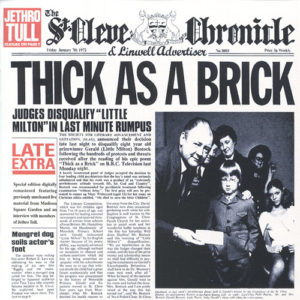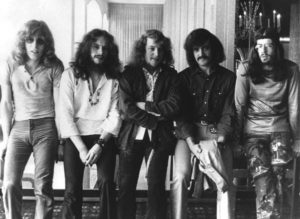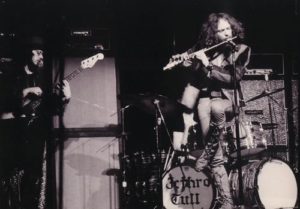
Jethro Tull | Thick As A Brick
A 45th Anniversary Retrospective
Original Label : Chrysalis (Europe) Reprise (North America)
Release Year : 1972
Country : United Kingdom
Genre : Progressive Rock
Original 1972
Band Members
Ian Anderson – Lead Vocals/Acoustic Guitar/Fute/Volin/Tumpet/Sxophone/Cover Art Producer
Martin Barre – Electric Guitar/Lute
John Evan – Organ/Piano/Harpsichord/Cover Art
Jeffrey Hammond (as “Jeffrey Hammond-Hammond”) – Bass Guitar/Spoken Words/Cover art
Barriemore Barlow – Drums/Percussion/Timpani
Additional Guest Musicians
David Palmer – Orchestral Arrangements
Terry Ellis – Executive Producer
Robin Black – Engineer
Contact Links
Jethro Tull Official Facebook Page
Jethro Tull Official YouTube Channel

Conceptual Blueprints #1
Throughout the history of progressive rock, the progressive rock epic has become a staple in the historical record of progressive rock. What do I mean by progressive rock epic. It is simple, a song that is 15+ minutes in length that transcends the original album they appeared on. In the progressive rock community in 1972, we witnessed a year of epics. Various epics that saw that light of day in 1972 are in no particular order, Yes’ Close To The Edge – 18:43 , Genesis’ Suppers Ready – 22:57 , Frank Zappa’s Waka Jawaka – 36:08 , Ash Ra Temple’s Schiwingungen – 38:04 and all four tracks that would make up Tangerine Dream’s Zeit, Birth of Liquid Plejades – 19:54, Nebulous Dawn – 17:56 , Origin of Supernatural Probabilities – 19:34 , Zeit – 16:58, etc …..
A little more history, due to the absolute time constrictions of the vinyl records of the day many of these classics came in 2 to 3 even more disc packages. The was a 22:05 restriction on each side of the vinyl records. It would only be later on Cassette and CD formats that we could really enjoy the progressive rock epic the way is was meant to be heard. Jethro Tull’s Thick As A Brick in reality was a 43:48 song that had to be divided into two sides due to industry restrictions. Side A was 22:39 and Side B was 21:09. I imagine if CD and Digital technology existed in 1972, the history of progressive rock and metal would be a whole different story.
Ian Anderson did Thick As A Brick as partial satire to where the progressive rock community started to go with longer more detailed compositions. In a interview with with PROG Magazine, Ian Anderson explained that Thick As A Brick was the basically the Monty Python to the progressive rock concept album of the day.
“Monty Python lampooned the British way of life,” says Anderson. “Yet did it in such a way that made us all laugh while celebrating it. To me, that’s what we as a band did on Thick As A Brick. We were spoofing the idea of the concept album, but in a fun way that didn’t totally mock it.”
Ian Anderson would go on in same interview and say that progressive rock had become all entirely ‘too serious’ feeling ‘too self important’
“When progressive rock started out, it was all about bands such as ourselves moving beyond merely being influenced by American blues. We stopped trying to be the next Fleetwood Mac or Chicken Shack – in other words, derivative of Elmore James – and began to take on board so many diverse musical ideas. It was exciting and dynamic. But, by the time the 1970s had begun, bands like ELP were a little up their own arses. Everything was too serious and overblown. So, we set out with Thick As A Brick to show up this side of the genre.”

Despite Ian Anderson’s reservations on portions of the industry at the time, Jethro Tull’s Thick As A Brick would go on to become both a legendary album and a album that now has its own ‘cult like’ following. It is due to those factors alone that I decided to present this 45th Anniversary Retrospective. The above mentioned epics and Thick As A Brick would go on to also influence many many more artists in contemporary progressive rock and metal community.
Conceptual Blueprints # 2
The idea to make Thick As A Brick into a very deliberate concept came from Ian Anderson’s irritation over the general public pigeonholing Jethro Tull’s previous album Aqualung into a conceptual piece. On the contrary it just had a general theme running through over a multiple tracked album. Ian Anderson told Teamrock’s Prog Magazine about the situation in January 2016,
“Not angry, no,” explains the man nearly four decades on. “I was actually mildly irritated and wryly amused. However much I insisted that Aqualung wasn’t a concept album, the media still persisted in treating it as such. They seemed to believe the whole record was a major religious story. The truth was that three or four songs were linked by questioning the nature of religion. But the rest were stand-alone tracks. So, after this whole scenario, I thought, ‘OK, we’ll not only now do a real concept album, but we’re going to make it the mother of all concept albums!’.”
The general story centers around autobiographical events through Gerald Bostock, Ian Anderson’s alternate ego and fictional character he created for Thick As A Brick. As Gerald Bostock, Ian Anderson questions the state of organized religion of the time. Here is what I see going on within this line of stiff scrutiny towards organized religion as it relates to Thick As A Brick.
A young man, full of vigour and not yet beaten down by the system, “sees” what’s wrong with society and can’t believe that the elders don’t see “it” also. I believe that Ian is this young man and that these ideas are illustrations of his opinions of what’s wrong with the world.
In Aqualung, the album just before TAAB, Ian attacks organized religion. He also examines the loveless, godless dregs of society.
In Chateau D’Isaster, the “lost” album just after TAAB, Ian attacks the Rat Race – the business people whom he charicatures as various types of animals. He also comments on Free Will vs. God-driven pre-destiny by likening Life to a stage upon which the sole actor (you, me, us) goes out onto without a script and has to improvise.
In TAAB and Roots to Branches, Ian examines how society and organized religion spread (by imprinting children before they become old enough to think for themselves).
In general, I feel that Ian believes in free will and in the humanitarian aspects of modern religions – we can determine our own actions and we are charged with the responsibility to act with compassion towards ourselves, other people, animals and nature. He believes that it is wrong to rely on a personified deity (“God”) – a god who will come riding in like the Great White Knight to “save” us from our own stupid actions. You can see this belief expressed throughout Aqualung, e.g. “He is the god of nothing, if that’s all that you can see, You are the god of everything, he’s inside you and me”.
Now I know there will be a bit of controversy with this. Some will agree or disagree with how God is looked at. That is not my intention to persuade somebody’s faith or religious beliefs. I am merely being as generally objective as possible. Some of the views expressed about the issue and subject of God even conflict with my own beliefs however still, my main focus is the facts and this was how the issue of God was viewed by Gerald Bostock, a.k.a fictional character of Ian Anderson as it concerns Jethro Tull’s Thick As A Brick.
The Anatomy Of A Epic – A Breakdown Of Jethro Tull’s Thick As A Brick.
Thick As A Brick – Sides #1 & #2
This was the only song on the album. Side 1 was “part 1,” running 22:31, and side 2 was “part 2,” clocking in at 21:05. Each side was over 20 minutes long.
A radio edit, running just 3:01, was sent to radio stations and is the version used on most compilation albums. Speaking with us in 2013, Ian Anderson explained: “back in 1972, you had to be aware of what was then called AOR radio – it was a delicate beast. It could only in most cases manage to play music that was in bite size portions. So we had to think about giving the option to American radio playing little edited sections of ‘Thick As A Brick,’ so they didn’t have to delicately drop the needle into the middle of a long track or lift it off after the three and a half minutes. So we did that specially for American radio.
It was never released publicly in that form, but in limited editions which were sent out to radio stations in the US, which is the only place where the record got played, anyway. It never got played in the UK or anywhere in Europe, it was just not that kind of music.”
“Thick as a brick” is a phrase meaning stubbornly dumb, as one’s head is so thick that no new thoughts can enter it. The song starts with Ian Anderson expressing his low expectations for his target (“I may make you feel but I can’t make you think”) before singing about class structures, conformity, and the rigid moralistic beliefs of the establishment that perpetuates it.
The song follows a young boy who sees two career paths: soldier and artist. He chooses the life of a soldier, just like his father. We see him assimilate into the society he once rebelled against, becoming just like his dad.
With minimal meddling, the album took only two weeks to record, and was written in less than a month. The packaging was designed to look like a small-town newspaper called the St. Cleve Chronicle and Linwell Advertiser. When opened, the album revealed 12 pages of newspaper stories, making innovative use of the square foot of sleeve space with a fold-out so the Chronicle measured 12″x16″.
Under the headline “Thick As A Brick,” we learn that an 8-year-old boy genius named Gerald Bostock wrote the lyrics for a poetry competition, but was disqualified on moral grounds by the governing body, The Society for Literary Advancement and Gestation (SLAG). According to the story, Ian Anderson of the “Major Beat Group” Jethro Tull read the poem and wrote 45 minutes of “pop music” to accompany it.
The newspaper also contained ads, recipes, TV listings, a crossword puzzle, and a review of the album. Jethro Tull wasn’t the first to use the newspaper theme for album art: The Four Seasons 1969 album Genuine Imitation Life Gazette was made to look like a newspaper with lyrics to the songs appearing as stories. It even had a comics-section insert.
In 2012, Ian Anderson recorded a sequel called Thick As A Brick 2 – Whatever Happened To Gerald Bostock? The album presents various outcomes for the now 48-year-old Bostock, including banker, preacher, soldier, and shop owner. Anderson says the album examines how “our own lives develop, change direction and ultimately conclude through chance encounters and interventions, however tiny and insignificant they might seem at the time.”
Anderson had never performed the original Thick As A Brick in its entirety, but later in 2012, he began a tour where he played the entire album and its sequel.
This continued an experimental phase for Jethro Tull. Their previous album, Aqualung, was considered a “concept” album, with characters and themes continuing from one song to the next. This was considered “progressive” rock, with very obtuse lyrics and a great deal of production. This song seems to be a commentary on modern society and the human condition.
In 2001, this was used in a Hyundai commercial. Group leader Ian Anderson recorded a new version for the spot to avoid having other musicians butcher his song, as is often the case in commercials. He improvised an outro which he felt was the best part, but it was edited out. Anderson does not drive a Hyundai. He calls himself a “professional passenger.”
This appears in an episode of The Simpsons where Lisa goes to the “Boy’s School.”
In the digital age, an album containing just one song doesn’t fit the download model. When the 40th Anniversary Special Edition was released in 2012, Ian Anderson divided the album into 8 different pieces that could be sold individually on iTunes and Amazon as $1.29 songs with titles like “The Poet and the Painter” and “See There a Man Is Born/Clear White Circles.” “Some artists choose not to do that – famously Pink Floyd – and don’t want to have their music unbundled to offer it in song length pieces,” Anderson told us. “But I accept that that’s the musical appetite of most folks these days. They don’t really have the time or the concentration to listen to a whole album in one go. They want it in manageable pieces.”




